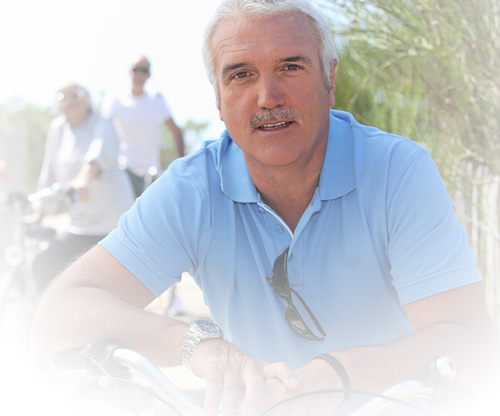Hormone Therapy
Traditionally, women have used hormone therapy to replace female hormones, such as estrogen and progesterone, that their bodies could no longer produce after menopause. Doctors prescribed hormone replacement therapies (also known as HRT) in order to prevent and treat menopausal symptoms such as hot flashes, night sweats and mood swings. However, some experts were concerned about the use of HRT in certain cases. Over the past decade, the development of bioidentical hormone replacement therapy (or BHRT) has resulted in improved safety for patients as well as a greater response to therapy. These days, however, BHRT isn’t limited exclusively to women. In fact, men also rely on hormone therapy in order to restore testosterone levels that lower gradually as they age.
Below is a list of some of the most common hormone therapies for both women and men, as well as the most common methods for delivering these therapies.

Hormone Therapies for Women
Bioidentical hormone therapy
Bioidentical hormones are a group of synthetic hormones designed to re-establish the body’s physiological balance. As its name implies, bioidentical hormones mimic the molecular structure of the estrogen hormones a woman’s body naturally produces. Introducing these bioidentical hormones can treat menopausal and post-menopausal symptoms, as well as reduce the risk of such diseases as osteoporosis and colorectal cancer.
Progesterone therapy
A hormone produced by the ovaries, progesterone plays a crucial role in maintaining pregnancy. Progesterone manufactured in a lab, known as synthetic progestins, can be used by women for a variety of reasons, including regulating their menstrual cycles and treating endometriosis (a thickening of the uterine wall). It can also be used to treat and prevent “estrogen dominance,” a condition in which the levels of estrogen in a woman’s body exceeds her progesterone (thereby resulting in a chemical imbalance).
Androgen therapy
Androgens, a steroid hormone that includes testosterone and androstenedione, are more commonly found in men than women. However, androgens in women are important because they are converted to estrogen and used to regulate bodily functions, particularly to the reproductive tract. In addition, a lack of androgens can lead to a condition known as adrenal fatigue, which in turn can affect physical, mental and emotional well-being. In women, adrenal fatigue is a common symptom of menopause.

Hormone Therapies for Men
Testosterone replacement therapy
Testosterone replacement therapy (TRT) replaces and restores the levels of testosterone in older men. Just as women experience lower estrogen levels during menopause, men can see their testosterone levels decrease (albeit at a slower and subtler pace) once they reach middle age. TRT heightens levels of testosterone, which has such effects as improved overall well-being and mood and an increased libido. It can also lead to a reduction in hypogonadism, a condition that stems from a testosterone deficiency.
Thyroid hormone therapy
Thyroid hormones are necessary in order to regulate the body’s metabolism. When the thyroid gland produces an excessive amount of the hormone thyroxine, the result is a condition known as hyperthyroidism. Some of the effects of hyperthyroidism include a rapid acceleration in metabolism, sudden weight loss, and a rapid or irregular heartbeat. Thyroid hormone therapy may also be used to raise thyroid hormone levels in the body if they prove to be abnormally low.
Adrenal fatigue
While women experience adrenal fatigue during menopause, in men the condition is directly tied to stress. It occurs when the adrenal glands are unable to produce cortisol, the hormone used to manage stress. If stress levels are too high and/or too prolonged, the body produces an excessive amount of cortisol to compensate. Symptoms of adrenal fatigue include chronic tiredness, reduced mental acuity and insomnia.

Hormone Therapy Methods
I – Intramuscular Injection
An intramuscular (IM) injection is the oldest, most common and least expensive means of providing hormone therapies such as TRT. IM injections introduce the hormone therapy deep in the muscles, thereby allowing it to be quickly absorbed into the bloodstream. Injectable hormone therapies are attached to a chain of chemical compounds known as esters that allow for a timed release of the hormone within the body. The most common IM injectable testosterone esters include cypionate, propionate and enathate, while for estrogen the most common esters are estradiol, estrone and estriol.
II – Implantable Pellets
The implantation of hormone pellets is another means through which doctors can deliver testosterone or estradiol hormone therapy to their patients. This method calls for a minor surgical procedure in which sterile, capsule shaped pellets are inserted under the skin. This allows for a low, constant dose of hormones to be released into the body as the pellets are designed to be resistant to breakage.
III – Buccal Troche
A troche is a small medicated lozenge that dissolves within the mouth after a period of approximately 10-20 minutes. Typically, the troche is inserted in the inside lining of the cheeks, also known as the buccal mucosa. Once the troche is fully dissolved inside the buccal mucosa, the hormones within the troche are then absorbed into the bloodstream.
IV – Transdermal Administration
Using the transdermal administration method, the hormones are applied directly to the skin using such means as creams, gels or patches. When applied on a regular basis, this method allows for a steady absorption of the hormones for systematic circulation throughout the body. Transdermal delivery systems are available in a variety of concentrations and combinations. For example, some doctors use transdermal creams or gels when administering progesterone as it offers a higher concentration of the hormone than oral methods.
[insert page=’16’ display=’content’]
[insert page=’43’ display=’content’]